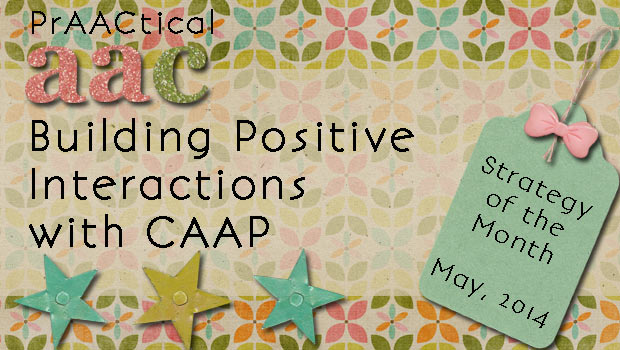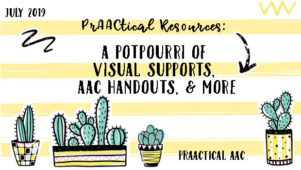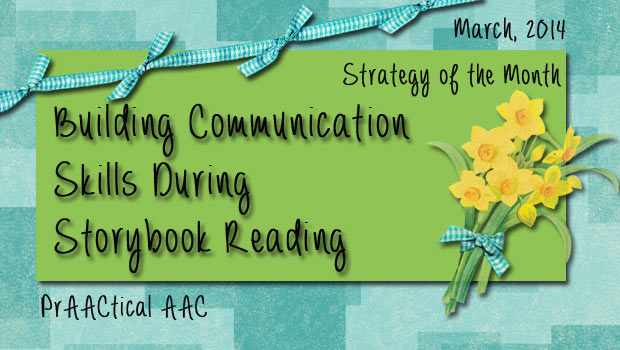Strategy of the Month: Building Positive Interactions with CAAP

One of the challenges in helping AAC learners maximize their communicative potential is that they often interact with people who do not facilitate positive interactions. We know, for example, that partners may focus on the SGD rather than the topic or communicator (e.g., “Can you find ‘go?’, “Press it again”). They may dominate the conversation by taking more than their fair share of turns, making for a lop-sided and uninteresting context that is more of a monologue than a true conversation. They also tend to interrupt the AAC learner, often in an attempt to guess the learner’s message, save time, or correct the person. These actions come from a good place (wanting to support the learner) but are not things that facilitate improved communication. In a previous post, we talked about the RAAP strategy, for building partner skills during storybook reading. In this post, we continue to share the work of Drs. Cathy Binger and Jennifer Kent-Walsh as we look at contexts other than shared reading. You can learn more about their work here.
The CAAP strategy can be used in school and home settings to support AAC learners in group activities, such as morning circle, or individual activities, such as pretend play, having a snack or meal, doing a craft, or completing math or science activities. It can also be used in community outings, such as going shopping or to the library. The versatility of the CAAP strategy makes it a great choice to teach to families and caregivers. Implementing this strategy requires that you have access to an AAC device or communication board with vocabulary appropriate to the activity, usually with a combination of core vocabulary and activity related fringe words. Appropriate fringe words might include the names of the people involved and the specific toys or materials being used. Here are the steps to the CAAP strategy.
Comment: The adult comments on something salient in the activity and provides aided language input by modeling two symbols on the AAC system. This is followed by a focused pause to observe for the learner’s response. Specifically, the partner looks expectantly at the learner while pausing for about five seconds to provide an opportunity for the learner to imitate our 2-symbol utterance. For example, in a race car activity, we might say ‘go up’ and then wait expectantly. If the learner imitates the model we provided, we respond with another 2-symbol utterance (e.g., go fast, do again, different car). If the learner doesn’t respond, we proceed to the next step.
Ask: Here, the adult then asks a relevant WH-question (using aided language input, of course) with two symbols on the AAC system. E.g., WHAT should we DO? This is followed by a pause to give the learner space in which they can respond. Like before, if they do, we provide another 2-symbol utterance to expand the interaction. If not, we move on to the next step.
Answer: Using aided language input, we answer the question posed in the previous step and then pause expectantly. If the learner imitates us, we move on and further develop the interaction with a new 2-symbol utterance. If not, then we go onto the final step.
Prompt: When needed, a 2-3 word prompt is provided (e.g., “Your turn;” “Tell me more”).
Have you tried the CAAP strategy? We’d love to hear about it.
Filed under: Strategy of the Month
Tagged With: CAAP, Cathy Binger, Jennifer Kent-Walsh, strategy
This post was written by Carole Zangari





5 Comments
Thank you for this! I love the acronym and the very clear explanation of how to use the strategy. I can’t wait to try it out!
Thanks for your positivity, Sarah. We’d love to hear from you when you try it out. Get in touch and let us know your thoughts on the experience, okay? Seriously. We’d really appreciate it. 🙂
Shouldn’t it be “tell me” two instead of “show me” two?
Maureen, that’s how I would probably do it, but when we share the work of others, we try to present it in a way that is true to the original form. As you alluded to, we love the idea of using the language of communication: tell, say, etc. Let’s build their self-image as communicators!
Do you have any direct links to videos of RAAP/CAAP ? Love to share with my TAs and teachers